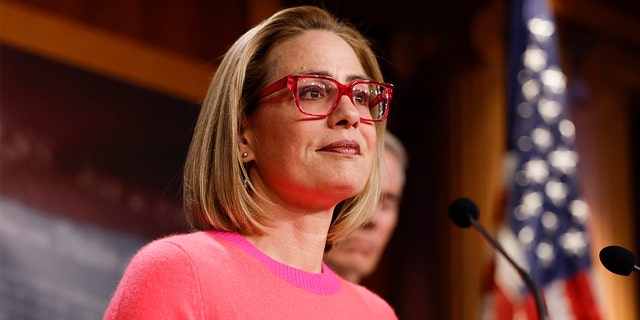Why it matters where Sinema caucuses after leaving the Democratic Party
“I’ve known Richard for such a long time,” said House Speaker Nancy Pelosi, D-Calif., of retiring Sen. Richard Shelby, R-Ala., the top Republican on the Senate Appropriations Committee. “I knew Richard when he was a Democrat. We go back a long way.”
Alabama voters first sent Shelby to Washington in the fall of 1978 as a freshman Democrat to serve in the House. Shelby moved to the Senate as a Democrat in early 1987. He switched his party affiliation from Democrat to Republican the day after the 1994 midterm elections. Shelby retires in early January as a conservative Republican — although perhaps not as conservative as some GOPers would prefer.
But as Pelosi says, few toiling in Washington these days remember when Shelby was a Democrat.
Shelby’s party switch in 1994 made a splash. Republicans had just flipped the Senate, scoring 52 GOP seats. Shelby’s move made it 53. Former Sen. Ben Nighthorse Campbell, R-Colo., ditched the Democrats a few months later, giving Republicans 54 seats.
OUTGOING ALABAMA SENATOR SAYS BODY ‘LESS COLLEGIAL’ THAN IS WAS 36 YEARS AGO
Shelby’s move the day after the election punctuated the bicameral Republican victories. Not only did it win the Senate, but the GOP seized control of the House for the first time in four decades.
Shelby’s decision to abandon the Democrats didn’t have any practical effect on which party controlled the Senate. However, it did make a statement, emphasizing that Washington was under new management.
“We’ll be happy to accept other applications,” Senate Majority Leader Bob Dole, R-Kan., proclaimed at the press conference welcoming Shelby to the GOP.
CONGRESS ACHIEVES ‘FRAMEWORK’ FOR OMNIBUS SPENDING BILL TO AVERT GOVERNMENT SHUTDOWN
In short, all party switches are not equal.
That brings us to the recent transmogrification of Sen. Kyrsten Sinema, I-Ariz. Sinema quit the Democrats and joined a political “Switzerland” occupied by independents Sens. Bernie Sanders, I-Vt., and Angus King, I-Maine. Yet Sinema, Sanders and King aren’t quite “Switzerland.” They agreed to “caucus” with the Democrats.
It’s notable that, like Shelby, Sinema announced her decision to leave the Democrats the day after an election. Sinema departed right after Sen. Raphael Warnock, D-Ga., prevailed in a runoff election over Republican challenger Herschel Walker.
Democrats were already assured control of the Senate after Sen. Catherine Cortez Masto, D-Nev., won her re-election campaign in mid-November. That guaranteed Democrats of at least 50 seats, and Vice President Harris could still break ties. Warnock’s win meant Democrats would then have 51 seats.

So Sinema waited until the Senate’s landscape was clear before bolting from the Democratic Party. A move prior to Warnock’s win would have called into question which party controlled the Senate. Moreover, it would steal the thunder Democrats needed to win in Georgia.
Therefore, Sinema waited until “the day after” to announce her defection. And Sinema still managed to steal thunder from Warnock.
Sinema is always in the middle. Now she’s truly in the middle.
KYRSTEN SINEMA’S SWITCH TO INDEPENDENT DESCRIBED AS ‘GUT PUNCH’ TO DEMOCRATS: ‘NO WIGGLE ROOM’
“Registering as an independent and showing up to work with the title of independent is a reflection of who I’ve always been,” Sinema said in a video.
However, Sinema would still “caucus” with the Democrats. That meant Democrat retained Senate control.
“It doesn’t change the complexion of what our Democratic majority is going to look like in the Senate,” said White House spokeswoman Karine Jean-Pierre.

The key here is the act of “caucusing.” Sinema indicated she will not caucus with the GOP and will still associate with Democrats.
Each senator notifies the secretary of the Senate as well as the “secretary for the majority” and the “secretary for the minority” for which team they’ll play.
In 2006, former Sen. Joe Lieberman, D-Conn., changed his affiliation from Democrat to “independent Democrat.” Lieberman’s contrived characterization wasn’t even formally recognized by the Senate. Lieberman technically left the Democratic Party after losing his primary. But Lieberman continued to caucus with the Democrats and won re-election.
That said, a senator could decide not to caucus with either side. That means neither the Democrats nor the Republicans will let you in “their room.”
“You can have a room. You’re just going to be the only person in it,” said Casey Burgat who teaches political science at George Washington University.

As they say, you want to be in “the room where it happens.”
For now, the Democrats are in the majority and control the “room.”
SINEMA’S EXIT FROM DEMOCRATIC PARTY OPENS THE DOOR FOR A GOP PICKUP – COULD SHE RUN AS A REPUBLICAN?
And, even if Sinema considered formally joining Republicans, it would have been foolhardy for her to leave Democrats and move to the minority.
That’s why Shelby and Campbell essentially rewarded themselves after Democrats lost control of the Senate in 1994. They’d be in the minority if they stuck with the Democrats. But the ol’ switcheroo propelled Shelby and Campbell into the majority when they signed up with Republicans.
In the case of Sinema, she got to enjoy the best of both worlds. She would remain in the majority but put a little bit of real estate between herself and the rest of the Democratic Party.
Sinema’s record with the Democrats was mixed. She provided a key vote to pass the Inflation Reduction Act. She was central to engineering passage of the bipartisan infrastructure bill. But Sinema bucked Democrats when it came to changing the filibuster.
Still, Republicans hope to court Sinema.

“We’d be happy to welcome her into our party,” said Sen. Tom Cotton, R-Ark., on Fox. “We’re a big tent party.”
Everyone’s eyeing Sinema’s next move.
VOTERS FIRED NANCY PELOSI, SO WHY ARE REPUBLICANS HELPING HER PASS ANOTHER SPENDING BILL?
“I watch Sen. Sinema,” said former Senate Majority Leader Trent Lott, R-Miss. “She spends a lot of time hanging out in the well of the Senate on the Republican side.”
Lott knows something about senators switching parties.
Lott was Senate Majority Leader in 2001. That’s the last time America had a 50/50 Senate. Republicans began the year in the majority due to the tie-breaking vote of former Vice President Dick Cheney.
But late Sen. Jim Jeffords, I-Vt., drifted from the GOP. A few months into 2001, Jeffords left the Republican Party and declared himself an independent. Jeffords decided to caucus with the Democrats.
That suddenly meant Democrats had 51 members and Republicans 49. Democrats immediately seized control of the Senate.
Sinema’s switch seemed eerily familiar to Jeffords’ move two decades ago.

“This ain’t that,” Burgat said of Sinema’s decision. “This seems to be a cosmetic change.”
Party control of the Senate didn’t move because Sinema decided to still caucus with the Democrats.
It is often said in politics that “where you stand is where you sit.”
That’s not entirely true when it comes to controlling the U.S. Senate.
What’s most important is where you caucus.
Read the full article Here


